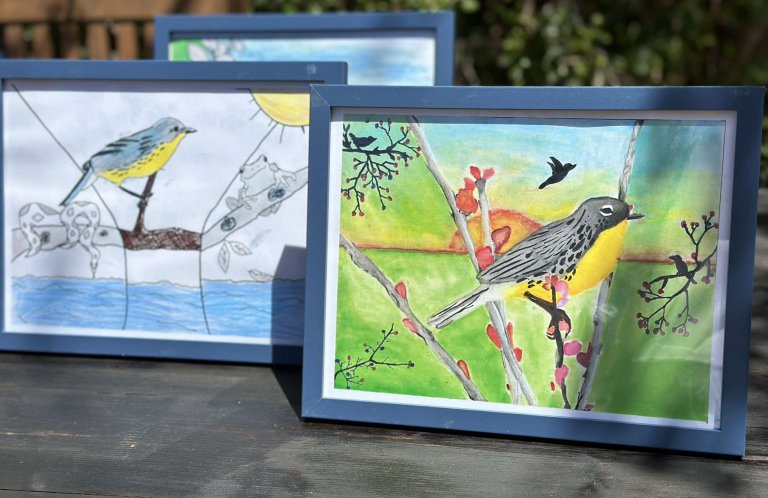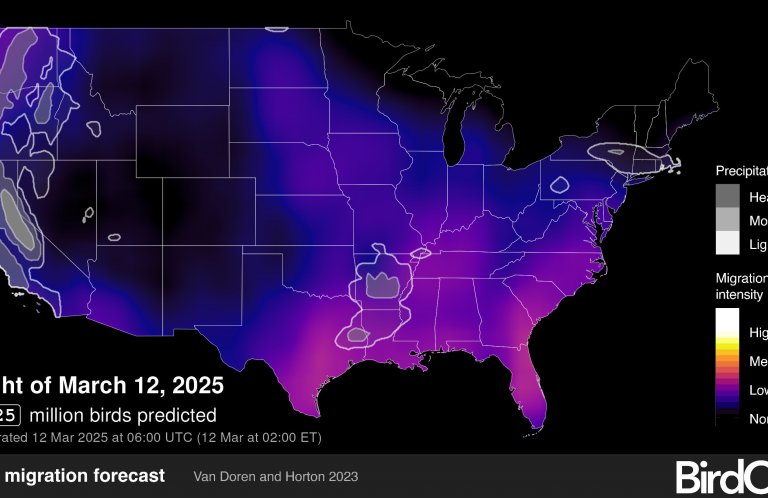Band-rumped Storm-Petrel and Hawaiian Ecosystems May Receive Federal Protection
The U.S. Fish and Wildlife Service proposed this week that a suite of 49 Hawaiian species be listed as endangered under the federal Endangered Species Act. Among the bees, shrimp, and plants put forward for protection is one bird species: the Hawaiian population of the Band-rumped Storm-Petrel, a small seabird believed to have dwindled to only 240 known pairs.

Band-rumped Storm-Petrel. The Hawaiian population has been proposed for listing under the Endangered Species Act. Photo by Glen Tepke
In this ecosystem-based approach, the Fish and Wildlife Service is proposing to list the petrel along with dozens of other species that share the bird's important and heavily impacted habitats: the coastal, dry cliff, and wet cliff ecosystems of Hawai‘i.
The Fish and Wildlife Service is now accepting public comments on the proposed listings, and will have 12 months to make a final decision. If the rule is approved, federal legal protection would extend to all 49 species, including the petrel.
Federal officials are urging such protection because of destruction and modification of habitat throughout each of the species' ranges. Non-native grazing mammals have exacerbated erosion and increased the potential for landslides, rock falls, or flooding, which in turn damages or destroys native plants and disturbs the Band-rumped Storm-Petrel's habitat. The Fish and Wildlife Service also noted that the increased frequency of hurricanes as a result of climate change could intensify the erosion and loss of nesting habitat for this species.
An Enigmatic Seabird
A mostly brownish bird with pale wing bars, the Band-rumped Storm-Petrel (Oceanodroma castro) is named for the white band across the top of its broad, triangular tail. The dainty seabird, known as ‘Ake‘ake to native Hawaiians, weighs only about one and a half ounces, a little more than a pat of butter. An adult bird can fit nicely into the palm of one's hand.
Once thought to be a single species occurring throughout tropical and subtropical areas, scientists suspect there may be as many as 10 geographically distinct populations of this bird, including in Japan, the Galapagos Islands, and several islands in the Atlantic. Classified within the family Hydrobatidae, “water walkers,” for the habit of some species to patter their feet on the surface of the water while feeding, storm-petrels in general are enigmatic. Their nesting areas are limited to small, protected crevices on coastal or inland cliffs, and lava fields at high elevation. Scientists have found only a few nests.

A Wilson's Storm-petrel pattering the surface while feeding. Storm-petrels are classified within the family Hydrobatidae, or "water walkers." Photo by Glen Tepke
The seabirds' nocturnal habits make them difficult to observe on land. Yet the recent use of recorders set up to automatically record the calls of birds as they fly into cliff nests have helped to document activity during the breeding period from May to July. The petrels lay one egg per year and can live as long as 15 to 20 years.
Threats to Seabirds, on Land and at Sea
Band-rumped Storm-Petrels haven't always been so rare. Researchers have discovered bones of this species on all eight main Hawaiian Islands, suggesting a historical abundance prior to the introduction of non-native mammals. Today, the storm-petrel's greatest threats are similar to those of Hawai‘i's other sea and land birds: non-native predators such as cats, rodents, and mongoose. Rats are the most prevalent and serious threat to the Band-rumped Storm-Petrel and are present on all main islands.

Endangered Hawaiian Petrels (pictured) and smaller Band-rumped Storm-Petrels face similar threats of predation by non-native mammals. Photo by Jim Denny
Other threats include light attraction and grounding of fledglings. Drawn to lights, the young birds become stunned, flying in circles until they land on the ground. Storm-petrels also have been grounded on cruise ships in Hawaiian waters.
A Push for Protection
The State of Hawai‘i listed the Hawaiian population of the Band-rumped Storm-Petrel as endangered in 2005. The proposal to list this population at the federal level would benefit populations on the islands of Lehua, Ni‘ihau, Kaua‘i, Maui, and Hawai‘i. The state is currently leading efforts in a second attempt to remove rats from Lehua.
We need greater conservation action to benefit this species. For that reason, American Bird Conservancy supports the federal listing of the Band-rumped Storm-petrel along with other species of the Hawaiian coastal ecosystem. Listing dozens of species that share coastal habitat and have common threats would allow for managing or eliminating these threats at an ecosystem level—a more cost-effective approach that should lead to better protection of resources for all native species.

Band-rumped Storm-Petrels may nest far inland in mountaintop colonies, sharing habitat with Threatened Newell's Shearwater (pictured). Photo of Newell's Shearwater by Jack Jeffrey
This important decision will result in greater attention to determine the extent of the storm-petrel's current population and identify conservation actions for this and other species of the coastal and cliff ecosystems. Meanwhile, ABC's Seabirds Program continues to prioritize conservation actions, including protection of the birds' habitat and control of predators, for the benefit of Band-rumped Storm-Petrel and other Hawaiian seabirds.
Editor's note: In related news, the Fish and Wildlife Service also took steps this week to protect several bird species in Central and South America and the Caribbean. The agency has listed the Military Macaw and Great Green Macaw as endangered under the Endangered Species Act, and proposed endangered status for Puerto Rico's Elfin-woods Warbler. Check back in coming weeks for more information, and to learn more about ABC's international work to improve prospects for these and other birds.
 Hannah Nevins is ABC's Seabird Program Director. She has nearly 20 years of seabird conservation experience, ranging from the clearing of non-native rats on nesting islands to assessing impacts of gill nets. She managed the response program at the Marine Wildlife Veterinary Care and Research Center at the California Department of Fish and Wildlife, was founding board member of Oikonos Ecosystem Knowledge, and is active in the Pacific Seabird Group. Hannah received an MSc in Marine Science from Moss Landing Marine Laboratories/San Francisco State University.
Hannah Nevins is ABC's Seabird Program Director. She has nearly 20 years of seabird conservation experience, ranging from the clearing of non-native rats on nesting islands to assessing impacts of gill nets. She managed the response program at the Marine Wildlife Veterinary Care and Research Center at the California Department of Fish and Wildlife, was founding board member of Oikonos Ecosystem Knowledge, and is active in the Pacific Seabird Group. Hannah received an MSc in Marine Science from Moss Landing Marine Laboratories/San Francisco State University.


















































